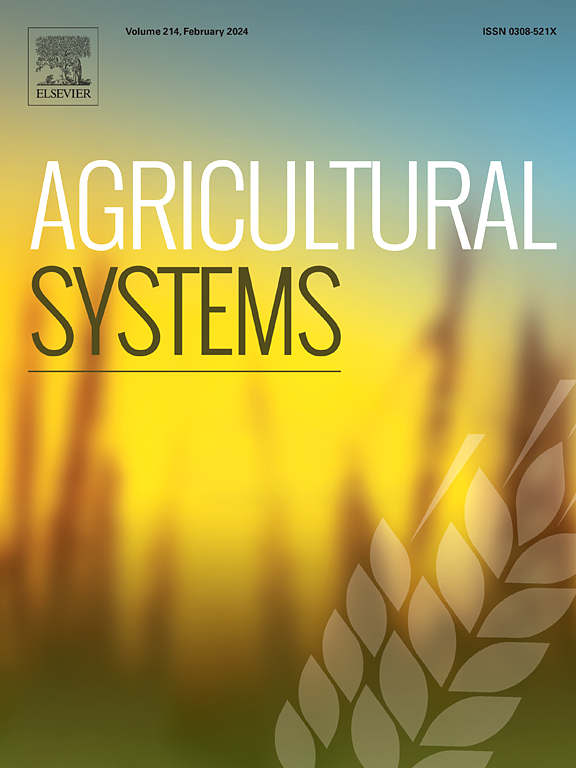多年生草地模拟轮牧过程中尿液对氮的吸收和淋溶及施肥
IF 6.1
1区 农林科学
Q1 AGRICULTURE, MULTIDISCIPLINARY
引用次数: 0
摘要
以放牧为基础的乳制品系统的生产力在很大程度上取决于氮(N)在土壤、植物和动物中循环时的可用性。然而,氮利用效率(NUE)一般低于40%,由于动物排泄的氮,特别是尿氮,由于高浓度的氮沉积而造成了显著的氮损失。本文章由计算机程序翻译,如有差异,请以英文原文为准。

Nitrogen uptake and leaching from urine and fertilizer applications during simulated grazing rotations of a perennial grass pasture
Context
The productivity of grazing-based dairy systems is driven in large part by availability of nitrogen (N) as it cycles though the soil, plant and animal. However, N use efficiency (NUE) is generally less than 40 % with significant N losses attributed to animal excreted N, especially urinary N, due to high N concentrations deposited.
Objectives
This experiment aimed to quantify N uptake, N transformations, and N leaching losses in a grazing-based dairy pasture and recommend strategies to enhance farm-system NUE.
Methods
A detailed experimental field site was established on a perennial ryegrass dominated pasture to measure the fate of N under contrasting fertilizer forms (urea or calcium nitrate) and artificial urine applications (400 or 800 kg N/ha), which aimed to reflect differing cow crude protein intakes. N uptake, use efficiency and leaching losses were determined over an 18-month period during typical grazing rotations and contrasting seasonal conditions.
Results and conclusions
Pasture yield response and N concentration reflected N rates applied. NUE from urine and fertilizer applications was highly variable and strongly influenced by soil moisture and temperature conditions. N applied increased pasture yields up to 8 months after application. Soil water N concentrations peaked and then decayed to background levels over a 3 to 4-month period, corresponding to N loads applied and soil moisture conditions. Regular urea and Ca nitrate fertilizer applications resulted in nitrate-N leaching losses of 92 and 97 kg N/ha, respectively. N leaching losses from urine treatments ranged from 168 to 735 kg N/ha, representing 21 to 46 % of total urinary N applied. The timing of urine applications was crucial, with over 40 % of urinary N leached when applied during the first half of the year (summer to autumn), compared to less than 21 % when applied in the second half of the year (late winter to spring).
Significance
Grazing-based dairy production systems result in high N loads from urine and fertilizer with highly variable pasture NUE in different seasons, and substantial N leaching. Improving the amount and timing of urinary and fertilizer N inputs is critical to increasing N use efficiency. Optimizing dairy cow N intakes through better balanced diets and restricting grazing and fertilizer applications during periods of low pasture growth are proposed management approaches to increase whole-farm NUE and reduce N losses.
求助全文
通过发布文献求助,成功后即可免费获取论文全文。
去求助
来源期刊

Agricultural Systems
农林科学-农业综合
CiteScore
13.30
自引率
7.60%
发文量
174
审稿时长
30 days
期刊介绍:
Agricultural Systems is an international journal that deals with interactions - among the components of agricultural systems, among hierarchical levels of agricultural systems, between agricultural and other land use systems, and between agricultural systems and their natural, social and economic environments.
The scope includes the development and application of systems analysis methodologies in the following areas:
Systems approaches in the sustainable intensification of agriculture; pathways for sustainable intensification; crop-livestock integration; farm-level resource allocation; quantification of benefits and trade-offs at farm to landscape levels; integrative, participatory and dynamic modelling approaches for qualitative and quantitative assessments of agricultural systems and decision making;
The interactions between agricultural and non-agricultural landscapes; the multiple services of agricultural systems; food security and the environment;
Global change and adaptation science; transformational adaptations as driven by changes in climate, policy, values and attitudes influencing the design of farming systems;
Development and application of farming systems design tools and methods for impact, scenario and case study analysis; managing the complexities of dynamic agricultural systems; innovation systems and multi stakeholder arrangements that support or promote change and (or) inform policy decisions.
 求助内容:
求助内容: 应助结果提醒方式:
应助结果提醒方式:


